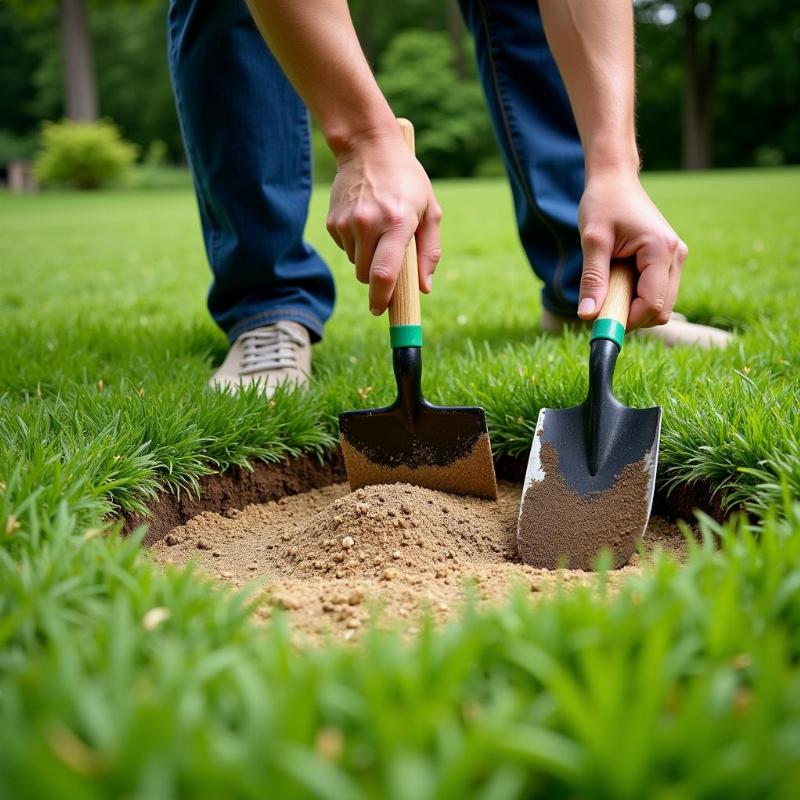Dog owners across America face a common challenge: unsightly brown spots on their lawns caused by dog urine. Finding the right grass fertilizer for dog urine is key to maintaining a healthy, vibrant lawn while also ensuring the safety of your furry friend. This article will explore the science behind why dog urine damages grass, offer practical solutions for repairing existing damage, and provide valuable tips on choosing the best grass fertilizer to prevent future issues.
Understanding the Science Behind Dog Urine Damage
Dog urine contains nitrogen, which in concentrated amounts can burn grass, creating those characteristic brown patches. The level of nitrogen varies based on your dog’s diet, hydration, and individual metabolism. While some believe female dogs are more likely to cause damage due to their squatting posture, male dogs can also cause significant damage over time.
The Role of Nitrogen and Salts
Nitrogen, while essential for plant growth, becomes detrimental in high concentrations. Think of it like over-fertilizing—too much of a good thing can have negative consequences. In addition to nitrogen, dog urine also contains salts which can dehydrate the grass, further contributing to the damage.
Choosing the Best Grass Fertilizer for Dog Urine
Selecting the right fertilizer is crucial for both repairing and preventing dog urine damage. Look for fertilizers specifically designed to counter the effects of dog urine. These typically contain lower levels of nitrogen and higher levels of potassium. Potassium helps to neutralize the salt build-up and strengthens the grass against future damage.
What to Look For in a Dog-Urine Resistant Fertilizer
- Lower Nitrogen Content: Opt for fertilizers with a lower nitrogen percentage to avoid further burning.
- Higher Potassium Content: Potassium helps to balance the high nitrogen levels in dog urine and promotes overall grass health.
- Added Micronutrients: Iron and other micronutrients can help to revitalize damaged areas and promote healthy green growth.
- Slow-Release Formula: A slow-release formula ensures a steady supply of nutrients over time, preventing rapid growth spurts that can be susceptible to damage.
Repairing Existing Damage
If your lawn already has brown spots from dog urine, there are steps you can take to repair the damage.
- Flush the Area: Immediately after your dog urinates, flush the area thoroughly with water. This dilutes the nitrogen and helps to prevent burning.
- Apply Gypsum: Gypsum helps to break down salts in the soil, making it easier for the grass to recover.
- Reseeding: For severely damaged areas, reseeding may be necessary. Choose a grass seed variety that is known for its tolerance to dog urine.
 Repairing dog urine spots on lawn
Repairing dog urine spots on lawn
Preventing Future Damage
Beyond using the right fertilizer, there are proactive steps you can take to minimize dog urine damage:
- Train Your Dog to Urinate in a Designated Area: This can be a designated spot in your yard, or you can train your dog to go on walks.
- Increase Water Intake: Encourage your dog to drink more water. This dilutes the urine and reduces the concentration of nitrogen.
- Dietary Supplements: Certain dietary supplements are available that claim to neutralize the nitrogen in dog urine. Consult with your veterinarian before adding any supplements to your dog’s diet.
Conclusion
Maintaining a lush, green lawn while sharing your space with a canine companion is entirely possible. By understanding the science behind dog urine damage, choosing the right grass fertilizer, and implementing preventative measures, you can keep your lawn healthy and vibrant for years to come. Remember to choose a fertilizer specifically formulated to counteract the effects of dog urine, prioritize lower nitrogen and higher potassium levels, and always consult with your veterinarian before making changes to your dog’s diet.
FAQ
- Why does dog urine turn grass brown? The high concentration of nitrogen and salts in dog urine burns and dehydrates the grass, causing brown spots.
- What type of fertilizer is best for dog urine spots? Look for low-nitrogen, high-potassium fertilizers specifically designed for dog urine damage.
- How can I repair existing damage from dog urine? Flush the area with water, apply gypsum, and reseed if necessary.
- Can I train my dog to urinate in a specific area? Yes, with patience and consistency, you can train your dog to urinate in a designated spot.
- Are there any supplements that can help with dog urine damage? Consult with your veterinarian about dietary supplements that may help neutralize nitrogen in dog urine.
- Will watering my lawn regularly help prevent dog urine spots? Yes, diluting the urine by watering the area immediately after your dog urinates can help minimize damage.
- Is there a specific type of grass that is more resistant to dog urine? While no grass is entirely immune, fescue and ryegrass tend to be more resistant than Kentucky bluegrass.
Related Articles
Beautdogs.us is your premier online destination for comprehensive and reliable information on all aspects of dog care and companionship in the United States. We offer expert advice on dog breeds, nutrition, training, and grooming, equipping you with the knowledge and resources to provide the best possible care for your furry friend. Whether you’re a seasoned dog owner or just starting your journey, Beautdogs.us is your trusted source for all things dog-related. Contact us today to learn more about our services! Email: [email protected], Phone: +1 501-555-7529.